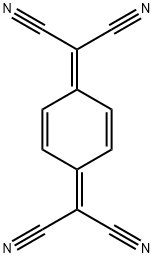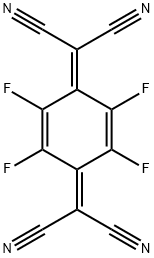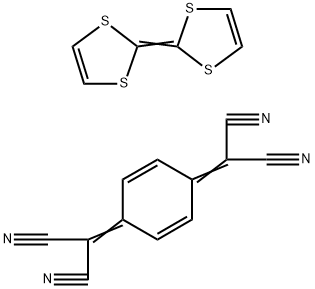7,7,8,8-Tetracyanoquinodimethane , 98% , 1518-16-7
Synonym(s):
(2,5-Cyclohexadiene-1,4-diylidene)-dimalononitrile;TCNQ;TCNQ, 1,4-Bis(dicyanomethylene)-2,5-cyclohexadiene
CAS NO.:1518-16-7
Empirical Formula: C12H4N4
Molecular Weight: 204.19
MDL number: MFCD00011664
EINECS: 216-174-8
| Pack Size | Price | Stock | Quantity |
| 1g | RMB239.20 | In Stock |
|
| 5G | RMB559.20 | In Stock |
|
| others | Enquire |
PRODUCT Properties
| Melting point: | 287-289 °C (dec.) (lit.) |
| Boiling point: | 332.67°C (rough estimate) |
| Density | 1.3596 (rough estimate) |
| refractive index | 1.5000 (estimate) |
| storage temp. | Sealed in dry,Room Temperature |
| form | Crystalline Powder |
| color | Orange-brown to green |
| Water Solubility | insoluble |
| semiconductor properties | N-type (mobility=10-5cm2/V·s) |
| λmax | 395nm(CH3CN)(lit.) |
| BRN | 611604 |
| Stability: | Stable. Incompatible with strong acids, strong bases, strong reducing agents, strong oxidizing agents. |
| InChI | InChI=1S/C12H4N4/c13-5-11(6-14)9-1-2-10(4-3-9)12(7-15)8-16/h1-4H |
| InChIKey | PCCVSPMFGIFTHU-UHFFFAOYSA-N |
| SMILES | C1(=C(C#N)C#N)C=CC(=C(C#N)C#N)C=C1 |c:8,t:0| |
| CAS DataBase Reference | 1518-16-7(CAS DataBase Reference) |
| NIST Chemistry Reference | Propanedinitrile, 2,2'-(2,5-cyclohexadiene-1,4-diylidene)bis-(1518-16-7) |
| EPA Substance Registry System | Propanedinitrile, 2,2'-(2,5-cyclohexadiene-1,4-diylidene)bis- (1518-16-7) |
Description and Uses
7,7,8,8-tetracyanoquinodimethane (TCNQ), with a LUMO at 4.5 eV, is known for the charge-transfer salts formed by its radical anion TCNQ in?photovoltaic, light-emitting diodes, and organic field-effect transistor?devices. TCNQ and its derivatives?have been used as dopants, leading to an increase in hole mobility or to the lowering of injection?barriers. One classic example of such is the treatment of tetrathiafulvene (TTF), an electron donor with TCNQ. TFF and TCNQ form an ion pair, the TTF-TCNQ complex. This process of doping leads to the crystallisation of the ion pair into a one-dimensionally stacked polymer. This polymer consists of segregated stacks of cations and anions of the donors and the acceptors, respectively. The complex crystal is an organic semiconductor that exhibits metallic electric conductivity [1, 2].
7,7,8,8-Tetracyanoquinodimethane is an electron-acceptor molecule used to form charge-transfer superconductors. It is an effective catalyst used for the ?-chlorination of carboxylic acids using chlorosulfonic acid; the presence of TCNQ suppresses competing free-radical chlorination.
Safety
| Symbol(GHS) |  GHS06 |
| Signal word | Danger |
| Hazard statements | H301+H311+H331 |
| Precautionary statements | P280-P301+P310+P330-P302+P352+P312-P304+P340+P311 |
| Hazard Codes | Xn,Xi,T |
| Risk Statements | 22-20/21/22-23/24/25 |
| Safety Statements | 22-24/25-36/37-26-36-45 |
| RIDADR | 3276 |
| WGK Germany | 3 |
| RTECS | GU4850000 |
| Hazard Note | Irritant |
| TSCA | Yes |
| HazardClass | 6.1 |
| PackingGroup | II |
| HS Code | 29269095 |





